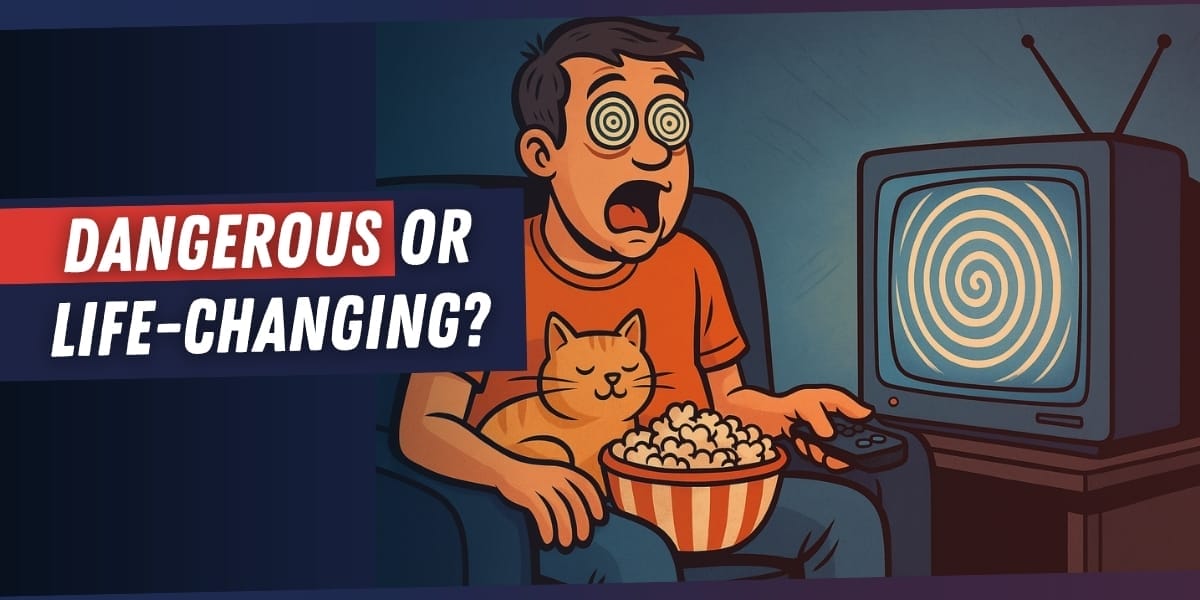Despite all the myths, hypnosis is real, and here to stay…
I’ve been doing hypnosis professionally for 50 years, and in that time I’ve heard just about every theory, explanation, and wild guess about what it actually is. After performing shows around the world, I’ve come across some truly strange beliefs—some amusing, some frustrating, and some that just won’t die.
For some reason, it seems like everyone’s an expert on the science of hypnotism—even those who’ve never experienced it firsthand. This often leads to a collection of wild opinions and half-baked ideas that fuel a whole range of persistent myths.
Some of these myths border on the nonsensical. Like this one, which I’ve heard at least a hundred times:
“You can get stuck in hypnosis!”
No you can’t.
Getting stuck in hypnosis would be like getting stuck in a conversation, or stuck while watching television - both of which can have hypnotic qualities. Can you imagine slipping into a TV trance, reacting emotionally to the story, then realizing you’re in hypnosis… and somehow unable to leave the couch and stop watching?
It doesn’t happen. And it never will.
“Hypnosis is dangerous!”
Also false. As the late, great trainer Dave Elman put it, “Hypnosis is no more dangerous than any other conversation.” It’s simply a focused and effective form of communication that taps into the deep well of the unconscious mind - where most of our resources actually live.
Then there’s the ever-popular fear that a hypnotist gains complete control over the subject’s mind. One man once told me, “Hypnosis is mind-control, plain and simple. It’s brainwashing people.”
Except it’s not. Not even close.
Subjects are always in control of what they say or do. At any moment, they can exit the trance if they feel like it. If a suggestion doesn’t feel right, they just ignore it - regardless of what the so-called all-powerful hypnotist says or commands.
In truth, the most powerful person in the room is the subject herself.
One of my personal favourite myths is this: Only about 10% of people are excellent hypnotic subjects. And supposedly, a whole segment of the population can’t be hypnotized at all.
So where does this come from?
Usually, it’s based on outdated experiments. Take a hundred people, play an old-school hypnosis record, and measure who goes into trance. The results? Predictably poor. There’s no live hypnotist to build rapport, no calibration, no tailoring the approach to the subject. Just a static audio track and a room full of people, many of whom will get nothing from it.
That kind of test tells us nothing useful. It’s a poorly designed way to judge hypnotic ability, because it removes the most important element: the human connection between hypnotist and subject.
Another common belief: Hypnotized people always have complete amnesia afterward, and awaken like they’re coming out of a general anaesthetic. That’s less a myth, and more of a misunderstanding.
Some people do slip into deep trances and emerge with memory gaps - partial or total. It’s common in somnambulism, the working state of hypnosis where change happens. But it doesn’t occur every time, and it’s not a requirement for effective trance. It’s just one possible hypnotic phenomenon, and it depends on the person, the depth, and the context.
There are also skeptics who believe hypnosis isn’t real at all. That it’s just role-playing, or imagination.
But modern research has laid that idea to rest. Functional MRI studies show real, measurable shifts in brain activity during hypnosis - especially in areas linked to pain perception, self-awareness, and the regulation of automatic functions. This isn’t guesswork anymore. It’s science.
Researchers like Dr. David Spiegel and Dr. Michael Yapko have brought hypnosis into the mainstream of psychology and neuroscience, showing how it can trigger meaningful, lasting change.
So why should this matter to you?
Because when you understand what hypnosis really is—not the myths, but the reality - you open a door to personal change, healing, growth, and improved performance. Whether you’re using self-hypnosis, working with clients, or just exploring how your mind works, the principles are the same.
Trance is natural.
Suggestion is powerful.
Change is possible.
The truth is, hypnosis is a normal part of being human. We all drift in and out of trance states every day - whether we’re driving, scrolling on our phones, or caught up in a good book.
Hypnosis simply helps you harness that natural focus. It’s a process of bypassing the critical faculty and accessing deeper internal resources - not some mystical power zapped into your brain from outside.
And here at Mike Mandel Hypnosis, we believe it’s not just a tool.
It’s a life skill.
And it belongs to everyone.
- Mike Mandel
(You can easily learn these same skills fast. Start for $1.)



